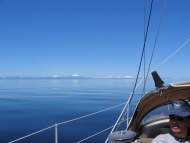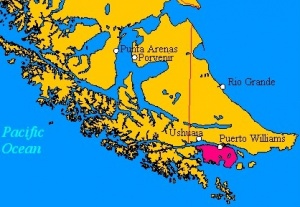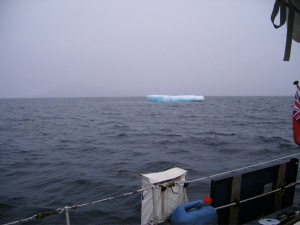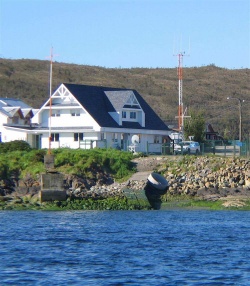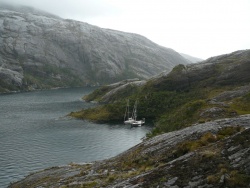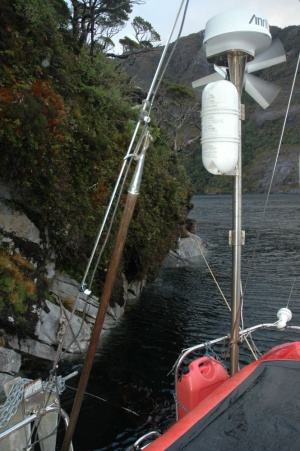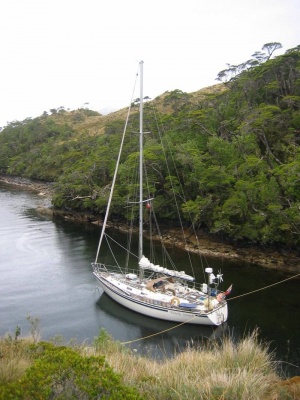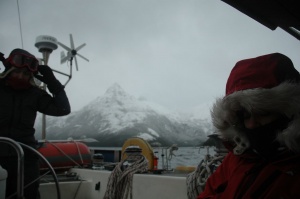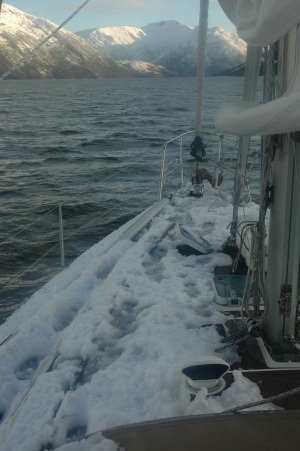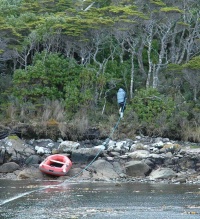Chile
From CruisersWiki
Chile Cruising Guide
An online cruising guide for yachts sailing around Chile.
| Chile | |
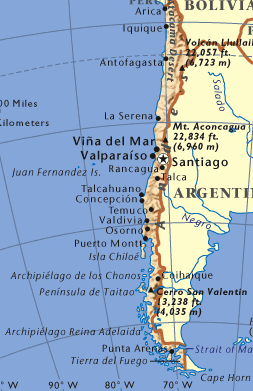 Chile | |
 Flag | |
| Capital: | Santiago |
|---|---|
| Language: | Spanish |
| Currency: | Chilean Peso |
| Timezone: | UTC-4 (winter), UTC-3 (DST observed) |
| More notes about the country | |
| | |
| Content - news items, etc. | |
Overview
Considered by many to be 'the last frontier' Chile has much to offer the more adventurous cruiser. The hardest thing - in the opinion of many people - is getting there.
Cruising the region
Filler text, please replace.
"Sed ut perspiciatis unde omnis iste natus error sit voluptatem accusantium doloremque laudantium, totam rem aperiam, eaque ipsa quae ab illo inventore veritatis et quasi architecto beatae vitae dicta sunt explicabo. Nemo enim ipsam voluptatem quia voluptas sit aspernatur aut odit aut fugit, sed quia consequuntur magni dolores eos qui ratione voluptatem sequi nesciunt. Neque porro quisquam est, qui dolorem ipsum quia dolor sit amet, consectetur, adipisci velit, sed quia non numquam eius modi tempora incidunt ut labore et dolore magnam aliquam quaerat voluptatem. Ut enim ad minima veniam, quis nostrum exercitationem ullam corporis suscipit laboriosam, nisi ut aliquid ex ea commodi consequatur? Quis autem vel eum iure reprehenderit qui in ea voluptate velit esse quam nihil molestiae consequatur, vel illum qui dolorem eum fugiat quo voluptas nulla pariatur?"
Climate and Weather
Chile has a wide variety of climatic conditions.
Northern Chile Extreme aridity prevails over the northern part of the country; the average annual rainfall in this region is 0.04 inches. Temperatures are moderate along the coast throughout the year and more extreme inland, especially in the central basin. The average temperatures for the hottest (February) and coldest (July) months are 72F and 60F. The weather in Iquique is typical of that experienced along the northern coast
Central Chile (30-40 degrees latitude) has a Mediterranean type of climate, with cool and rainy winters (April to September) but without a completely dry season. Average annual precipitation increases substantially and temperatures decrease toward the south. The average temperatures for the hottest (January) and coldest (July) months at Santiago are 68 F and 46.6F, respectively. The average annual precipitation at Santiago is approximately 15 inches.
Southern Chile The climate of the southern region is cool and rainy the year round. It is characterized by abundant low clouds. The average temperature for the warmest (January) and the coldest (July) months are 57F and 40F respectively.. The average annual precipitation is 119 inches. The changes of the snow line on the westward-facing slopes of the Andes can serve as an indication of the variation in climatic conditions with latitude and altitude. The line of permanent snow is approximately 18,000 feet in Chile's extreme north. It descends to 14,000 feet opposite Santiago and to 2,200 feet at Tierra del Fuego. Once east of Brazo Noroeste rainfall decreases considerably as one is then under the lee of the Andes. The temperatures also become more extreme, warmer in summer and colder in winter. In Puerto Williams the temperature rarely gets above 2°C in June/July
Puerto Montt to Golfo de Penas While this area experiences a lot of rain throughout the year good sailing can be had from October through to April. Northwesterlies produced by lows close offshore in the Pacific bring the rain. When the almost stationary South Pacific High that normally lies off the coast of central/northern Chile manages to work its way south periods of calm and dry weather with truly remarkable visibility are the result.
Golfo de Penas to Estrecho de Magallanes Wet throughout the year with more rain and wind in the summer months. Lows coming out of the Pacific are blocked by the Andes and tend to slide down the coast until they get south of or over Tierra del Fuego and can escape into the Atlantic. The result is a lot of north westerly weather ...with rain... which is funneled down the Channels and can make a northbound trip rather hard work. Tends to be quite mild at sea level.. the temperature rarely falls below 0°C in the summer.
Estrecho de Magallanes to Cabo de Hornos Once beyond Cabo Froward/Canal Cockburn the weather gets noticeably dryer the further east you go. It also becomes a lot colder in winter and warmer in summer. Don't let the idea of a southern summer fool you, it can snow to sea level in December and January. It is also possible to experience vast differences in conditions over a 24 hour period as the weather systems pass through here at a very rapid rate. My experience suggests that the most settled weather comes with a very low and steady barometer while a rising barometer brings the strong westerlys. Easterlys are rare but not unknown.
Weather forecast sources
- Chilean Navy Weather Forecast Center An excellent source of information on Chilean weather for when you are shore based.
- Chilean Wefax schedule The NOAA global wefax schedule.
- Sailmail.com Gribs via Sailmail or Winlink.
- Wx by voice. Weather forecasts are also read, twice daily in Spanish, by coast radio stations on 4146 kHz USB. They are also promulgated on VHF in the south by the manned lighthouses and the various Armada and Alcamar stations. times to be advised. The latter will also give you the latest forecast on request.
The preferred navigation charts for use in Chile are, not unsurprisingly, those produced by the Chilean Hydrographic Service (SHOA). These are produced to a high standard but unfortunately due the age of much of the survey work many of the charts south of the Golfo De Penas exhibit errors in longitude. This error is often in the order of 2 miles. Experience with electronic charts suggests that these charts show the same errors and in many areas the electronic charts give no worthwhile coverage at all. This is yet another reason why nocturnal navigation is not recommended. What every yacht should carry is the 'Atlas Hidrográfico de Chile' which contains - at a reduced scale - a copy of every Chilean chart. Make sure you have a good magnifying glass and be aware that these charts date from about 2002. The Chilean Tide Tables - 'Tablas de Marea de la Costa de Chile' - should also be on board.
Charts and publications are available in, as well as the northern ports, Punta Arenas and Puerto Montt. Very limited availablity in Puerto Williams if at all.
Buoyage in Chile
In common with the rest of the Americas Chile is an IALA B country ( red right returning). 'From seaward' is taken to mean from south to north through the channels ( an exception being Canal Magdalena ) unless they have east west orientation in which case the buoyage runs from west to east. In the approaches to ports the buoyage runs as you would expect it to run. An interesting feature is that the greens have can topmarks and the reds have cones.
Night navigation is not to be recommended unless unavoidable. South of Golfo de Penas this is due to the poor quality of the charts in many areas together with the risk from ice. In the vicinity of Tortel/Rio Baker tree trunks can be a problem. North of Melinka the risk is mainly due to fishermen's gear. In all southern areas night navigation involves the risk of being hit by 'rachas' without notice which is as good a way of losing your rig as any.
Local Radio Nets
Also see World Cruiser's Nets
- The Patagonian Cruisers' Net is on 8164 USB at 0900 Chilean Local Time ( 1300 UTC/GMT winter, 1200 UTC/GMT summer ) throughout the year. Operated by Wolfgang Kirsten out of Villarrica in Región de La Araucanía.
- The "Rueda del Pacifico" "Pacific net" in Spanish operated by radio amateurs on 14.370 USB every day at 2030 Chilean local time (0030 UTC/GMT winter, 2330 UTC/GMT summer).
Chilean Arrival/Departure procedures
The Zarpe In this country the Armada de Chile controls the movement of everything in, on or under the sea. Prior to undertaking any voyage in Chilean territorial waters it is neccesary to obtain what is known as a Zarpe or combined port clearance and passage plan. These come in a variety of forms.. I have been issued with some 'Autorizacion de Zarpe', a few 'Formulario Condiciones de Zarpe de la Embarcacion' and several 'Declaracion de Salida' . To obtain a zarpe one has to apply in writing giving name and details of the yacht including fuel, water and 'autonimia maxima' - the number of days you can go without resupply. Also required are the details of the master and crew , proposed route and anchorages, together with ETA at the next Armada port.
For a voyage through the channels this can and should be left quite vague, simply naming the main channels that you intend to use and giving a worst case ETA next port - better to arrive early rather than late. For a Zarpe out of Puerto Williams for either a 'Circuito de Ventisqueros' or 'Hornos' one must be far more specific as a far closer watch on yachts is kept in this area for a number of reasons.
Puerto Montt There is no problem obtaining a Zarpe in this port covering the entire passage to Pto Williams. Some yachts in Pto Montt have been subjected to safety equipment inspections before the issuing of a Zarpe for both domestic and international voyages.
Puerto Williams Call 'Puerto Williams Radio' on VHF 16 one hour before ETA. Advise again when secure alongside Micalvi. As of April 2011 captain and crew had to walk up to the Port Captain's office to clear in and - if coming from overseas - complete Customs,Immigration and Quarantine paperwork.
Punta Arenas Call 'Punta Arenas Radio' on VHF 16 one hour before arrival advising where you intend to berth. Once secure alongside you must go to the Port captain's office which is a few minutes walk to the north east of Muelle Prat.
During the austral summer of 2007/8 it was possible - on 4 days of the week (Tue/Wed & Sat/Sun) - to clear out of Chile for Ushuaia from Puerto Navarino if arriving from the north or returning from a 'Circuito de Ventisqueros'. It is not permitted to enter in to Chile at this port for a voyage north through the channels. In that case it is required to enter in at Puerto Williams and request a Zarpe in that port.
Armada and Alcamar
Armada port is the expression commonly used to describe a port that has a Capitán de Puerto as invariably the port has both an Armada - or Navy - presence and a port captain who looks after matters both mercantile and civil. These are the ports where you are obliged to present yourself at the Capitánia clutching both your Zarpe and your spanish phrase book. Alcaldías de Mar or Alcamars on the other hand are more of a sub branch. In the northern part of Chilean patagonia they are to be found in many of the smaller ports such as Quielen. They are also supposedly situated on islands such as Mechuque although I have never found that one.
In the south, in the region of the Beagle Channel and Cape Horn, they take on a different form. Here at places such as Timbales pic , Yamana and Cape Horn itself they are essentially coastwatch stations, manned in the main by a single Armada rating and his family who serve a twelve month hitch. Throughout this area you will find yourself giving ETDs ETAs and QTHs several times a day. The reason for this close interest in your movements is twofold ... firstly it is a very hostile environment you are sailng in down here... secondly you are sailing near a very sensitive border.. Chile nearly went to war with Argentina not that many years ago over the disputed islands to the east of Isla Navarino. A full list of Capitán de Puertos and Alcaldías de Mar can be found at Directemar Follow your nose down past 'Frecuently(sic) Asked Questions'.
Position Reporting
There are two conflicting requirements when it comes to position reporting. One is that you are required to send your position twice daily to the Armada...the other is that you are only required to carry VHF.....
If you do only have VHF then you simply pass your position to any Alcamar ports or posts or manned lighthouses (essentially Faros Raper, San Pedro and Fairway) that you pass. South of Golfo de Penas you will also be called up by the pilots on any passing ships. If you have admitted to having HF then you have two choices, either waiting until every fishing boat in the south has passed their QTH on 4146 kHz and then try and pass yours...good luck! Better by far is to email your QTH to the Armada once per day by either Sailmail or Winlink.
Immigration & Customs
Authorities in this country are very correct and efficient and are a pleasure to deal with. In Puerto Williams and to a lesser extent Puerto Montt they are very familiar with yachts. It is possible to keep a foreign yacht in Chile for two years. On arrival the Aduana(Customs) issues a 'Declaracion de Admision Temporal' which is valid for 12 months. This can be extended for a further 12 months by applying in writing to the Aduana in your port of entry for a 'Prorroga'. This must be done before your intitial 12 months is up.... failure to do this may see you facing a fine of $200 Chilean pesos ( about $US400 )
Visas
A 90 day visa is granted on arrival in the country. It is possible to get a 90 day extension without leaving Chile but this takes time and costs money. As the border is never far away most cruisers find it easier to make a visa run into Argentina.
Health & Security
While the population in general are a very friendly and honest people the major centres have a serious pickpocket problem.
Chilean Ports & Popular Stops
- Antofagasta (Port of entry)
- Arica (Port of entry)
- Castro (Port of entry)
- Chacabuco (Port of entry) A handy port if a 'visa run' into Argentina is required. (See Details)
- Iquique (Port of Entry)
- Puerto Aguirre .(See Details)
- Puerto Eden (Port of entry) - A required stop when on passage either north or south through the channels. (See Details)
- Puerto Montt (Port of entry) (See Details)
- Puerto Natales (Port of entry)
- Puerto Navarino (Port of entry (See note above)) (See Details)
- Puerto Puyuhuapi A convenient diversion when northbound. (See Details)
- Puerto Williams (Port of entry) - The administrative centre for Magallanes y Antártica Chilena. (See Details)
- Punta Arenas (Port of entry)- a port best treated with caution.( See details)
- Quintero ( Port of Entry)(See details)
- Talcahuano (Port of entry)
Also see nearby Bahia Coliumo - Valdivia (Port of entry)
- Valparaiso (Port of entry)
Offshore Islands
- Offshore possessions
Coastal Passages - North & South
It is generally considered that Southbound passages through the Patagonian Channels may be made with a generally favourable wind at any time of the year. Northbound late autumn/winter is considered the most settled time while spring/early summer is considered the worst. From May through into September many of the anchorages south of Puerto Eden are iced up, especially vunerable are ones that have fresh water entering them or have glaciers in the vicinity.
Good anchorages are normally considered to be those where it is possible to lie to an anchor and two stern lines and where one can make the land one's friend. Many people come unstuck simply because they are unwilling to tuck in close enough to the land. A simple rule is that no trees = windy...trees = sheltered. At least two 'full coil' ie 220 metres shore lines should be carried together with two half coils for use where it is possible to run four lines. Polyprop, which floats, is the shore line of choice. While some boats have their shore lines stored on reels others stow their ropes in 'bolsas para verduras'
200 hours/1000 miles of motoring between Puerto Montt and Puerto Williams or viceversa is not an unreasonable expectation if any sort of schedule is to be maintained and this should be taken into account when calculating diesel requirements (see Puerto Eden above) .
A good reliable engine is essential and plenty of spare parts, from impellers through head gaskets to starter motors should be carried. If you didn't bring it you aren't going to have it........and its a long walk to the shops.
Cruiser's Friends
Submit details/contacts of cruiser's "friends" that can be contacted in advance or on arrival - who can offer information and assistance to our cruising "family".
References & Publications
- Patagonia & Tierra del Fuego Nautical Guide, 2nd Ed. by Mariolina Rolfo & Giorgio Ardrizzi is the standard reference work for the waters from Valdivia, Chile to Mar del Plata, Argentina.
- Navigation Guide to Chilean Patagonia, Guia de la Navegación del Yatista para los Canales de Chile , 3rd Ed. by Alberto Mantellero.
- Chile - Arica Desert to Tierra del Fuego, 2nd Ed. by the RCC. covers the waters from Arica to Tierra del Fuego
Links to Forum Discussions
- The Wiki's "Chile" page discussion - Discuss this page.
- Chile Sailing and Cruising Discussions on Cruisers Forum
External Links
- http://www.directemar.cl/
- http://www.meteochile.cl/
- http://www.panoramio.com/user/55032 - Photos of cruising in Chile which are linked to Google Earth.
- Wikipedia - Chile
Personal Notes
Staying Warm and DryBetween Golfo de Penas and Tierra del Fuego the weather comes in three forms.....very wet, very cold or very wet and very cold. As a result staying warm and dry becomes the main focus of existence. For much of the year temperatures rarely rise above 5*C and after you factor in the wind chill and add a bit of sleet it is not a lot of fun. Make no mistake...this is a hard climate.
Keeping the body warm and dry isn't too hard but I have found that fine wool merino base layers are far and away superior to synthetics. They don't itch and they don't pong. In winter I have found that it is not uncommon to be wearing four layers.. other crew have had more... I think six layers under their foulies is the current record.
Standard 'yachting' seaboots are a waste of boat space down here. For running lines I have found the white 'Bata' boots which you can buy in the Covepa farmers' co-ops in Puerto Montt are good as they have 'all terrain' soles which get a better grip on wet rocks. For use on board you can't do better than good insulated winter boots such as Sorells
Keeping hands warm is a more complex matter and I don't think there is any such thing as a perfect glove. I think that a selection of gloves for different usage is the way to go.... I'm currently using red rubber gloves for handling lines, climbing gloves (don't forget to seal the seams) with liners for steering and a fluffy little pair for just sitting around in.
Once secure for the evening there is normally a race to get the best spot on top of the engine for drying out small pieces of kit.
In bed some people swear by sheets made from polartec fleece. My favorite bit of bedding next to my skin is an Australian 'searug'.
Cabin Heating and Insulation
Some form of cabin heating is a must. I have an Eberspaker that I am quite happy with, its only down side being that it uses electricity as well as diesel. This may be one reason that I try to keep the cabin fairly close to ambient... about 10°C keeps me happy... the crew? oh they grumble a bit..... first up in the AM turns on the heater and it goes off again after breakfast. Same routine again in the early evening. Apart from the saving in power and diesel it also seems to keep down condensation. The boat is a standard GRP production boat... the only major area of concern was the alloy framed ports and hatches... problem solved with self adhesive foam 'draft excluder' attached to any proud bits of alloy and then the ports are double glazed with cling wrap stuff.... works well. Only other area of concern is the inside of the lockers.... I plan to insulate them with styrofoam sheet this year.
Running Lines I have heard it said that a hard dinghy or at the very least a RIB is required in these waters as the 'razor sharp mussels' will destroy a basic inflatable. I have been using a 16 year old very basic Achilles since arriving in Chile and it has yet to suffer any bottom damage.
The Kelp Knife
Kelp is a feature of the south and a good kelp knife is an essential piece of boat kit. My favoured style involves an old oar, a boathook, or similar with a serrated bread knife secured to the end. Slide it down the chain or across the face of the anchor and the kelp is gone.
|
|---|
|
Names: |
| |
|---|
| | HOMEPAGE | Wiki Contents | South America | East Pacific | South Atlantic | Cape Horn | Chile | |
